Imagine walking around Times Square in New York City. A family of Japanese tourists approaches and asks you for the name of the block you’re standing on.
You explain that you are on 47th, between Broadway and 8th.
The Japanese family looks at you with bewilderment and repeats the question, “what is the name of the block?”
A little confused, you clarify, “we are on 47th Street, between Broadway and 8th Avenue.”
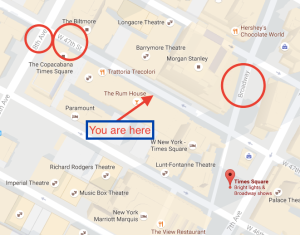
Unfortunately, you have not helped the Japanese family and they move on in search of Bubba Gump Shrimp Co. still lost and confused.
Now, imagine you are in Tokyo. You are a bit lost and ask someone, “what street are we on?”
The person looks a little confused, points across the street and says, “that is block 24 and we are on block 25.”
You probably hang your head to the side as you try to make sense of this answer. Going for it one more time, you ask, “what is the name of this street?”
The Japanese local responds, “that is block 24 and we are on block 25. Streets do not have names, blocks have names. Streets are the empty spaces between the blocks.”
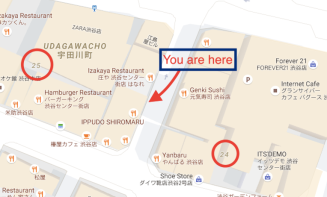
All of a sudden, that run in with the Japanese family in Times Square starts to make sense.
The Japanese not only label their blocks as opposed to streets (some major streets have names, but not most), the house numbers do not go in order based on location, they are numbered based on when they were built.
When I was in Japan, I couldn’t wrap my head around how they managed to navigate with such a backwards address system. I couldn’t understand how anyone knew where they were going. Yet, this system works just fine in Japan.
Addresses were not the only thing that appear backwards and upside down in Japan to a foreigner (or Gaijin in Japanese). When I told my friends and family I was traveling to Japan, they all said I was in for a major culture shock.
After spending 6 weeks in Japan, with a trip to South Korea mixed in, I realize my friends and family were right. However, the differences are not as extreme as you may think; a little weird for sure, but sometimes things that are different and a little weird aren’t necessarily so bad.
When I arrived, I felt like a child. I pointed at menus to order food. I relied on seven words of Japanese and Tarzan-like English to communicate. I smiled and nodded a lot in an attempt to not offend anyone (I probably offended some people anyway, but at least I tried).
I’d have a rush of excitement when I got the hang of something or learned a new word. The same type of excitement you experienced when you were able to ride your bike down the street without training wheels and not fall off. I wasn’t accomplishing anything spectacular. I was getting used to walking on the left side of the sidewalk, receiving change with two hands or walking up the right side of an escalator as opposed to the left. It was all about the little victories.
There is a lot to get used to.
Everything in Japan opens late. There are a few exceptions, but most stores and restaurants don’t open until 10-11AM, even on the weekends! Imagine if we did that in the States. There would be a mass hysteria if us millennials couldn’t roll out of bed and get a bottomless Bloody Mary with our Eggs Benedict for brunch.
Once things are open, Tokyo is an amazing city. Having spent most of my life in New York and Washington D.C., one of the most glaring differences is the quality of public transportation.
Being better than the Washington D.C. Metro is not much of an accomplishment. However, in Japan, trains are always on time, run every 5 minutes, connect to every corner of the city, are wonderfully air-conditioned and are – drum roll please – clean.
When I say clean, I do not mean simply free of visible debris, I mean spic and span. In contrast, when I hopped on the D.C. metro upon arriving back in the States, I had to avoid an empty “Big Bite” 7-11 container, covered in mustard, on the only open seat.
During my first few trips to the train station in Japan, I noticed there were all these yellow paths with little ridges leading everywhere. Given how concerned the Japanese are about safety, I was shocked they would have such a blatant tripping hazard all over the place. I felt like skipping along and singing “follow the yellow brick road,” until I was informed that they are there to help blind people navigate the train station safely.
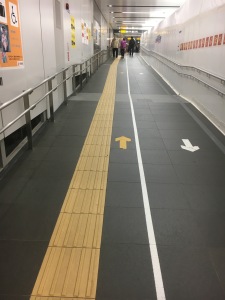
The subway system is not the only place that is clean, the whole city is pristine! It is common to see city workers and store owners, cleaning the sidewalks and the exteriors of buildings every day.
There is virtually no trash on the ground, not even cigarette butts. On it’s own, this is not groundbreaking, but it is impressive when you realize there are virtually no public trash cans on the street. I am not exaggerating, you would often walk blocks and blocks before running into some small receptacles outside a convenience store. Each bin is labeled for burnables, glass or plastic.
Furthermore, these few trash cans are never overflowing like you would see at a park or neighborhood with a vibrant nightlife on the weekends in the U.S.. The Japanese are very careful with their trash situation and you don’t see many people carrying Orange Mocha Frappaccino to-go cups on the street. Japan puts even the most progressive college campuses to shame that think they are reducing their carbon footprint.
This is not to say everything is perfect. Most public restrooms are often not equipped with soap or paper towels. You know you are in a fancy shmancy area when the bathroom has paper towels. Most locals carry lots of hand sanitizer and follow the BYOT rule (Bring Your Own Towel).
Once you get past those short comings, the bathroom situation is actually quite lovely. Unless you find yourself stuck with a squatty potty, every toilet is complete with a bidet and heated seat. Talk about a big variation, either a hole in the ground to squat over, or a luxury spa for your bottom. I was skeptical of the bidet at first, but once I got used to it, a little rinse before reaching for the toilet paper is a massive upgrade. Japan is the land of the cleanest streets and the cleanest buttholes, just bring your own soap.
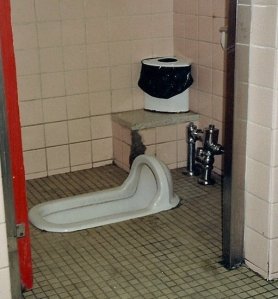
The bathroom feature that blew me away had nothing to do with cleanliness. Toilets in restaurants and nice areas have noise makers that produce the sounds of a toilet flushing or birds chirping. Imagine, you never have to be embarrassed about the plippity ploppity and splashy noises you make when nature calls.
Another big difference in Japan is related to crime: there is none! Every English-speaking bartender and local says that if you miss the last train home, you could pass out on the street with your wallet in your hand and wake up with it in your pocket.
I did not test this theory out myself, however, the way people behaved made you feel like crime is less of an issue as it is in major cities in the States. It was common to see people asleep outside the train station after a night of drinking. People did not lock up their bikes. Business folks would go to the bathroom at coffee shops and leave their laptops on the table. Stores had large displays of goods outside without anyone making sure anything walked away.
I realized how conditioned I am to think that some degree of crime is normal. When I first arrived, I thought these store owners were crazy and these people were stupid to leave their bikes and belongings unattended. By the end of my trip, I realized they weren’t the silly ones for being so trustworthy, I was for being so speculative.
I am sure you have seen the ads on trains in the U.S. that warn you to keep your phone and bags close by so they are not easily grabbed by thieves leaving the train. There are no such ads to be found in Tokyo. There are, however, signs reminding you to give up your seat for the elderly, a pregnant woman or someone with a disability. Different for sure, but that really highlights the priorities and concerns of the community in Japan.
Not all signs or ads are quite so noble. A few examples include: cautioning drunk people to be careful by the tracks, warning you not to use a selfie stick near the tracks to avoid being electrocuted, and my favorite, a sign by the escalator warning men not to take pictures up women’s skirts (for real).
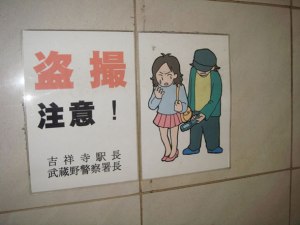
Maybe some folks are a tad perverted in Japan, but at least they are taking measures to curb such behavior. This sign is not the only precaution for creepers. All Japanese cell phones have a security feature that ensures the phone makes the “click” noise when you take a picture. This way, no one can take a picture of you without everyone around knowing. Luckily, phones in the States can be set to silent, which helped me take this picture of some dude passed out on the train one morning…
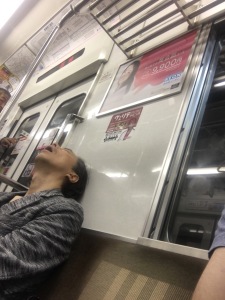
Moving on to food. There are definitely some interesting features and practices in the world of Japanese food.
First, the Japanese love vending machines. They are everywhere. You can’t walk more than a block without running into a machine selling water, soda, alcohol (yes alcohol, no open container law!) or hot coffee. The hot coffee brand “Premium Boss,” oddly uses Tommy Lee Jones and a stoic Japanese dude in sunglasses as their spokesmen.
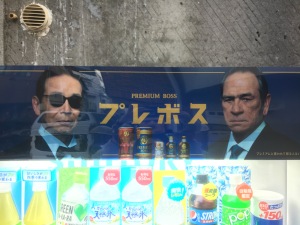
Vending machines are not limited to soft drinks and Tommy Lee Jones sponsored caffeinated beverages. A lot of restaurants use vending machines for you to place your order. You put in your money, pick your meal, a ticket prints and you hand it over as you walk in.
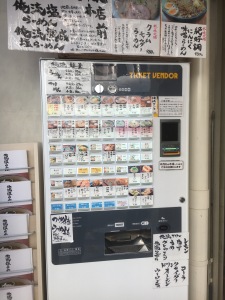
With my experience in the restaurant business, I am skeptical about how this would fly in the States. The Japanese are not big on substitutions, while most Americans read a menu as a list of suggested ingredients that can be interchanged at will.
The Japanese don’t allow such requests just to be a pain. They want you to order items as is to ensure a quality product. There is nothing more frustrating in the restaurant business, than a person who would create their own dish only to be disappointed that it isn’t as good as they expected (that’s why it isn’t on the menu!). I actually respect the Japanese for sticking to their product and not allowing for variation they do not control.
A lot of friends asked me if I ate sushi for breakfast, lunch and dinner. Surprisingly, I ate less sushi than I would have expected. The sushi I did partake in is leaps and bounds better, fresher and cut in vastly larger pieces than any sushi spot in the US. If your idea of sushi is the roll variety, covered in spicy mayo and crunchy toppings (sorry Dad), you are in for disappointment. I do not believe there is any spicy mayo in the entire country. This was exclusively sashimi and nigiri land, and it was glorious.
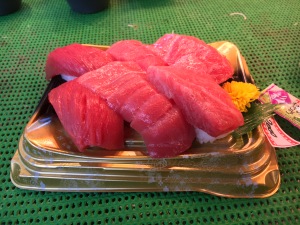
There are a lot of great things to eat away from raw fish. Yakitori, grilled meat on a stick, was very popular and a delicious meal or snack. Dumplings were pervasive and amazing. The Japanese take their noodles very seriously; udon (thick noodles), soba (buckwheat noodles) and my favorite, ramen (not instant), is available on every block. Ramen also doubles as a late night snack spot. I am fairly certain ramen is some type of ancient hang over remedy.
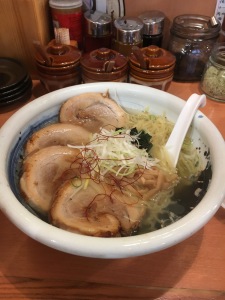
Most restaurants in Japan encourage reservations and are skeptical of accepting walk-ins. There were several instances when a restaurant would be reluctant to seat a party of 2 at 6:00PM because they were holding that specific table for an 8:30PM reservation. The restaurant manager in me wanted to shake them by the collar and explain to them how much money they were losing with this practice. Upon reflection, I began to respect these establishments for running their businesses the way they want to and avoiding anything that might diminish the experience for their customers.
The music played in restaurants and bars is pretty spectacular. One afternoon, I went to a restaurant that did not have an English menu. After a five-minute ordering process with the one lady who kinda spoke English, I sat down and took in my surroundings. I realized they were playing “Endless Love” on the radio. Don’t get me wrong, this soulful ballad by Lionel Richie and Diana Ross should be appreciated by different cultures, but I was definitely the only customer who understood the words.
One night at a bar, there was an eclectic Funk band performing. Until you see a Japanese man sing “She’s a Brick House,” you simply have not lived.
Besides all the institutional and cultural differences, I had some experiences during my time in Japan (and South Korea) that I would never have done in the States.
I rode a go-cart, dressed as Luigi from Mario Kart, in the streets of Tokyo.
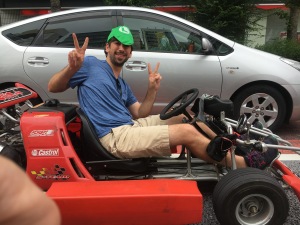
I went to a baseball game where the there is no middle-aged man screaming, “ICE COLD BEER HERE!” Instead, there are petite Japanese women running around with back packs filled with kegs. Oh, and the team’s name is the Tokyo Yakult “Swallows” (referring to the bird, get your head out of the gutter).
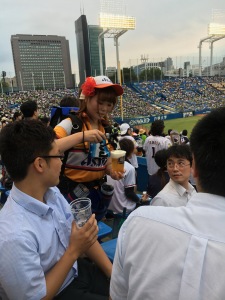
I went to a Robot Show, which consisted of four acts that can only be described as some sort of live anime with monsters, robots and people. They were playing drums, and then fighting, and then dancing to Michael Jackson music, and then fighting some more. I am pretty sure there was supposed to be a story line, but the volume of neon lights, smoke and debauchery made it hard to follow. Luckily, they serve beer. If given the opportunity, go to the Robot Show and prepare to get weird, really weird.
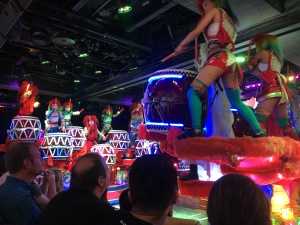
I bathed naked at a natural hot spring spa called an Onsen. (For obvious reasons, there are no pictures to accompany this experience)
I went to the Demilitarized Zone between South and North Korea. I was close enough that I could hear the propaganda North Korea blasts through speakers to entice the South Korean’s to defect over the border. In retaliation, the South Korean’s play Korean Pop music back at North Korea (can’t say they don’t have a sense of humor).
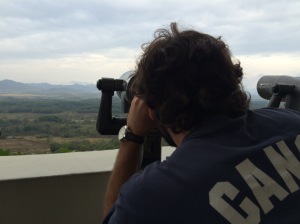
I went to the official “Cup O’ Noodles” museum and made my own “Cup O’ Noodle.”

I went to an Owl Cafe, which did not live up to the Harry Potter like expectations I had. PETA would have disapproved, but how often do you get to hold an owl?!

While there was plenty of weird by American standards, there was also plenty of normal. Lots of beautiful parks, fascinating museums, cultural festivals, delicious food and impressive temples, shrines and architecture.
At the end of the day, I have learned from the people in Japan that the world is a lot less daunting than we often make it out to be. Yes, things are different. Yes, things can be a little weird, but my experience in Japan has led me to believe that weird and different isn’t necessarily as bad as we anticipate. Often, our fears and lack of understanding paralyze us from doing something that can turn out to be amazing and unforgettable.
It is easy to watch the news these days and think that the world is a dangerous and scary place. However, walking the streets of Tokyo felt just as safe, if not safer, than the streets of D.C. or New York. Do you need to use some common sense and avoid some sketchy areas? Of course you do. Are there still some bad people out there? Absolutely. But, it seems like the world is generally filled with a lot of good, decent, friendly and hospitable people.
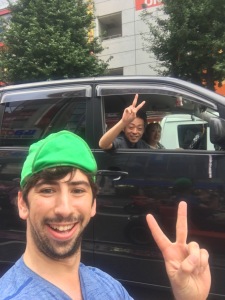
This extended time out of the country has been one of the most eye-opening experiences of my life. I always dreamed of having an experience like this and until now, I had always had an excuse to avoid taking the plunge. If I learned nothing else, I learned this: If you want to take a trip or experience something new, don’t wait for all the traffic lights of life to turn green (because they won’t) and don’t let fear get in your way. Be like Nike and “Just Do It.”
Now that I am back in the States, I am not thinking about if I will take another trip like this, I am thinking about when and where.

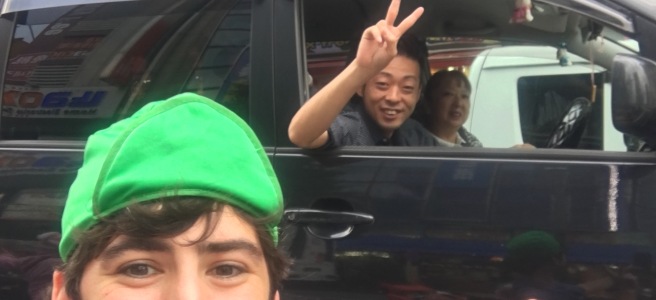
I loved this review of Japan. I too had a similar experience of Tokyo when I visited ten years ago. I intend to return in 2020 for the Olympics and to climb Mt. Fuji. There’s a ramen shop near the top of the mountain. Plus, you can get a walking stick stamped for every so kilometers. What an awesome perspective.
LikeLike
Mt. Fuji is still on my list of things to do in Japan. Unfortunately, climbing season was over when I got there. I would also climb mountains for good ramen!!
LikeLike
I only had one short week in Tokyo, but I had many similar experiences Jeff! I too was impressed most by the cleanliness, excellent public transportation and incredible safety!
Ditto though on your comment about WMATA setting the bar of public transportation expectations pretty low. I vote they hire in a whole new team from Japan to take over!
LikeLike
When I got on my first metro ride back in DC, the only empty seat was being occupied by a used “Big Bite” box from 7-11 covered in mustard. I stood.
LikeLike
Hello Jeff,
Your words on Japan has made me want to experience ‘different’. Now I am planning a trip to Japan after reading your review. Excellent writing. Keep up the good work.
Kudos.
Ramjith
LikeLike
Thanks Ramjith! Good luck on your journey. I really enjoyed checking out your website! Nice to know there are others out there chasing the life they want to live!
LikeLiked by 1 person
It’s interesting to read visitors’ image of Tokyo. Sounds like you had an enjoyable visit!
>Streets do not have names
Actually, all major streets in Japan have names. Tiny roads don’t. And Japanese mailing addresses don’t use the street names.
>I noticed there were all these yellow paths with little ridges
I wrote about “accessibility in Japan”:
https://tokyo5.wordpress.com/2010/04/24/accessibility-in-japan/
>People did not lock up their bikes.
Actually, everyone in Japan locks their bicycles…but Japanese bicycle locks are different from American ones. You may not have noticed the locks.
LikeLike